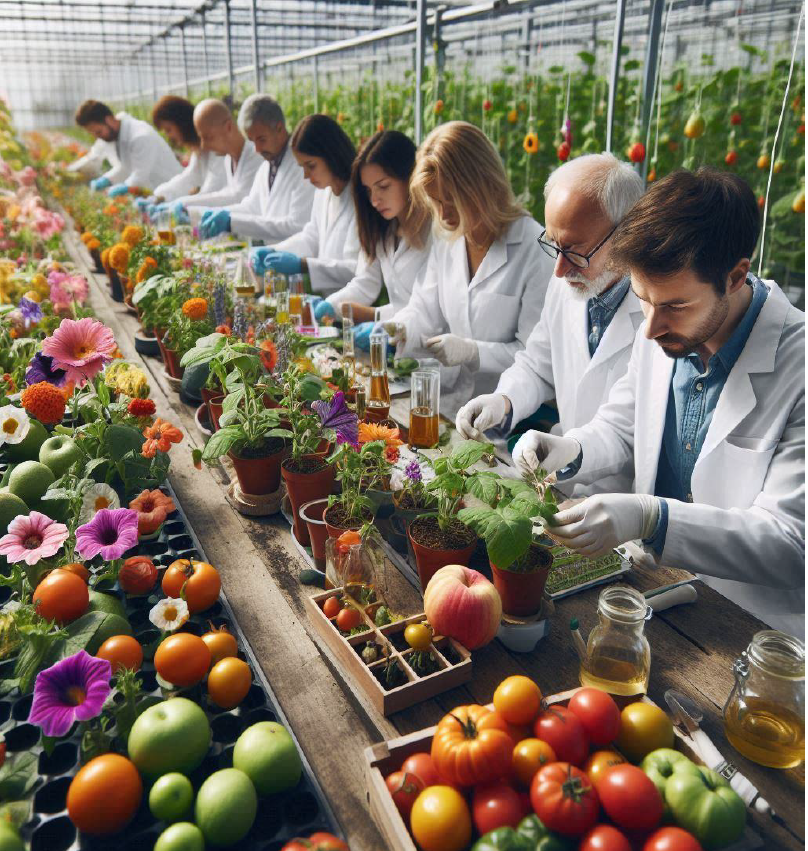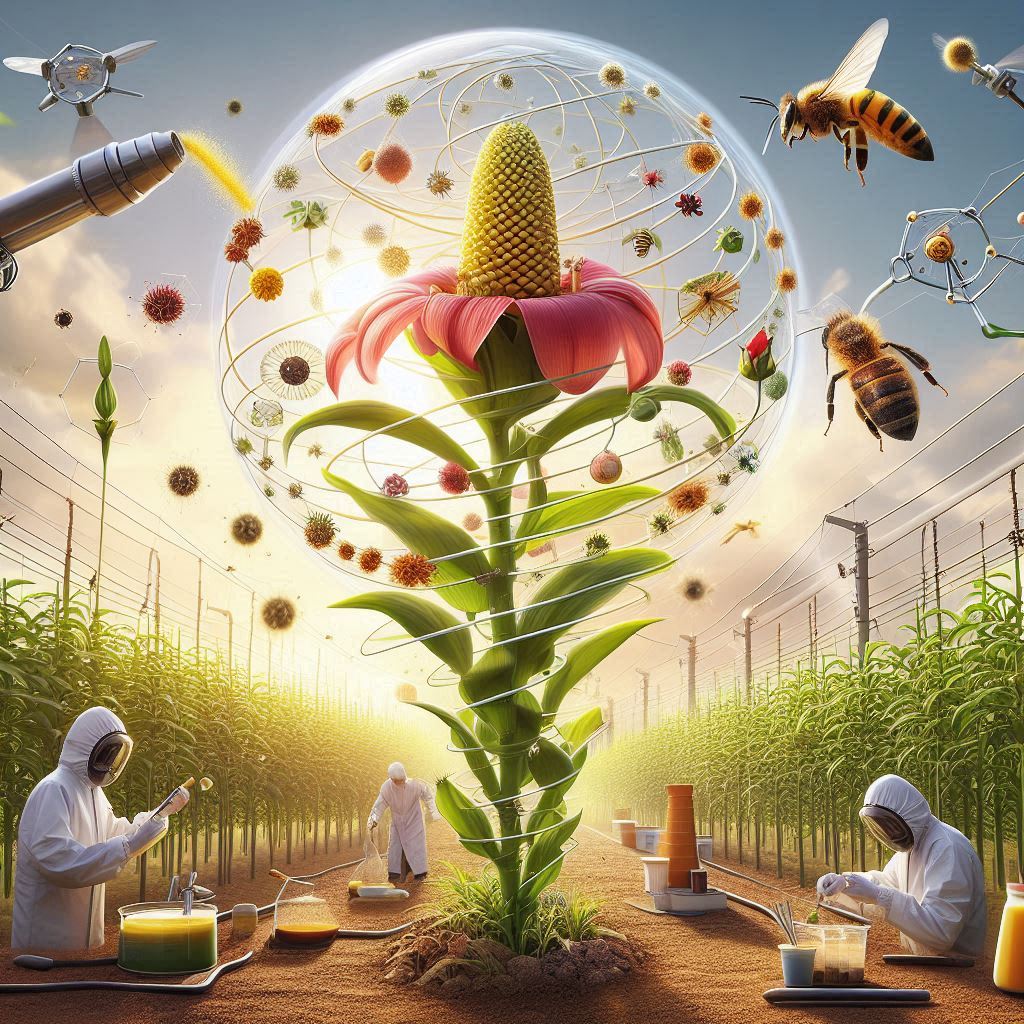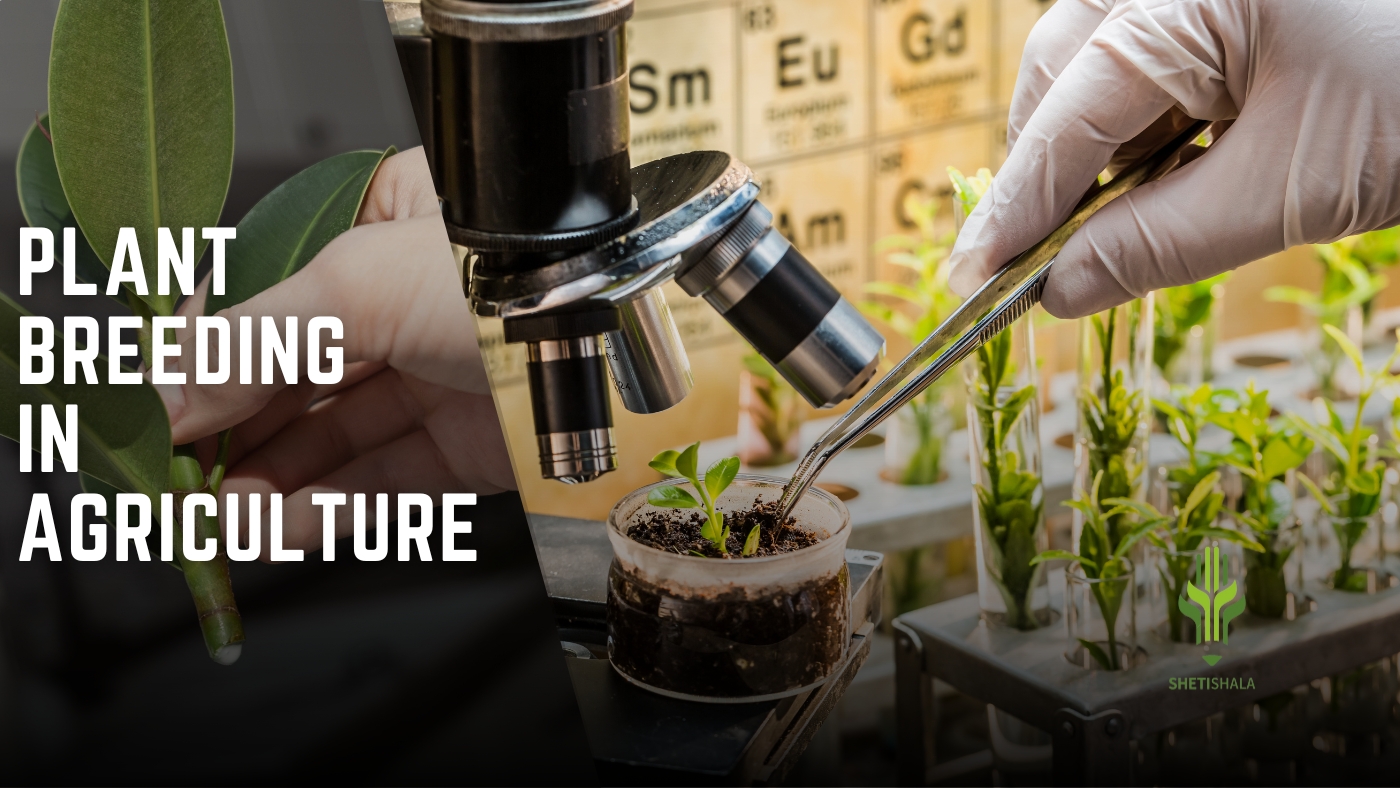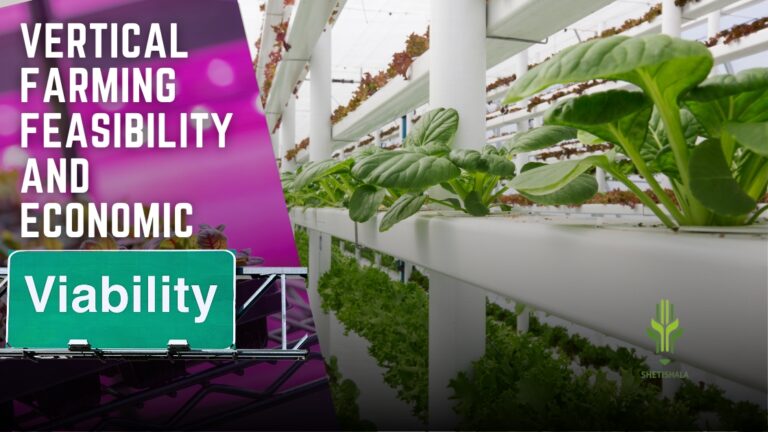Introduction
Discover the vital role of plant breeding in agriculture through our detailed blog. Learn about the essential steps in the plant breeding process, from selecting parent plants to harvesting and evaluation. Explore conventional breeding techniques that have shaped the development of high-yield, disease-resistant crops. Gain insights into how these methods contribute to improving crop quality and ensuring food security. This blog provides a comprehensive overview of plant breeding in agriculture, highlighting its importance in creating resilient and productive agricultural systems.
Definition:-
Plant breeding is the science and art of improving plants for the benefit of humanity. It involves manipulating plant traits to create new varieties that are better suited for cultivation, more productive, resilient to pests and diseases, and adapted to changing environmental conditions. Here’s a detailed explanation of the key aspects of plant breeding.

Aims and Objectives of Plant Breeding :-
The objectives of plant breeding are multifaceted and aim to improve various aspects of plants to benefit humanity and the environment.
Here’s a detailed exploration of the primary objectives:
1. Yield Improvement:
Increasing the productivity of crops by developing varieties that produce higher yields per unit area or per plant. This helps to meet the growing demand for food, feed, fiber, and other agricultural products.
2. Quality Enhancement:
Improving the quality of harvested produce in terms of nutritional content, flavor, texture, aroma, shelf-life, and suitability for processing or storage. Quality enhancement ensures that crops meet consumer preferences and nutritional needs.
3. Disease Resistance:
Developing plants that are resistant to diseases caused by pathogens such as fungi, bacteria, viruses, and nematodes. Disease-resistant varieties reduce crop losses and the need for chemical pesticides, promoting sustainable agriculture.
4. Pest Resistance:
Creating plants that are resistant to insect pests, thereby reducing crop damage and the reliance on synthetic pesticides. Pest-resistant crops contribute to environmental sustainability and minimize health risks associated with pesticide use.
5. Abiotic Stress Tolerance:
Enhancing the ability of plants to withstand adverse environmental conditions such as drought, heat, cold, salinity, and soil acidity or alkalinity. Tolerant varieties ensure stable production in challenging environments and regions affected by climate change.
6. Adaptation to Specific Agro-climatic Conditions:
Tailoring plant varieties to thrive in diverse agro-climatic zones, including varying temperatures, rainfall patterns, altitudes, and soil types. Adapted varieties maximize agricultural productivity and resilience under local environmental conditions.
7. Nutritional Enhancement:
Improving the nutritional composition of crops to address deficiencies in essential nutrients (e.g., vitamins, minerals, proteins) in human diets. Nutrient-enhanced varieties contribute to improved public health and well-being.

8. Resistance to Herbicides:
Developing plants that tolerate specific herbicides, allowing for effective weed control without harming the crop. Herbicide-tolerant varieties facilitate more efficient and environmentally friendly weed management practices.
9. Efficiency in Resource Use:
Optimizing the use of natural resources such as water, nutrients, and light to maximize crop productivity while minimizing environmental impact. Resource-efficient varieties promote sustainable agriculture and conserve natural resources.
10. Novel Traits and Innovations:
Introducing new traits into crops through biotechnological approaches such as genetic engineering. This includes traits like improved photosynthetic efficiency, enhanced nitrogen fixation, and resistance to environmental pollutants.
11. Conservation of Genetic Diversity:
Preserving and utilizing genetic diversity within plant species to maintain resilience and adaptability to changing environmental and agricultural conditions. Conserving genetic diversity ensures the availability of genetic resources for future breeding efforts.
Steps in Plant Breeding Process :-
The plant breeding process involves several systematic steps aimed at developing new plant varieties with improved traits. These steps integrate scientific knowledge, genetics, and agricultural techniques to enhance crop productivity, quality, and resilience. Here’s a detailed explanation of each step in the plant breeding process:
1. Objective Setting and Planning:
•Identification of Traits: Define the specific traits (e.g., yield, disease resistance, quality) that need improvement based on market demands, environmental challenges, and consumer preferences.
•Target Environment: Determine the target agro-climatic conditions where the new variety will be grown to ensure it meets local requirements and challenges.
2. Germplasm Collection and Evaluation:
•Collecting Genetic Diversity: Gather diverse plant materials (germplasm) from wild relatives, landraces, modern cultivars, and gene banks. This step ensures a broad genetic base for breeding.
•Initial Screening: Evaluate collected germplasm for desired traits and genetic variability through phenotypic (observable characteristics) and genotypic (genetic makeup) assessments.
3. Genetic Crossing and Hybridization:
•Selection of Parents: Choose parent plants with complementary traits that are desired in the offspring.

• Cross-Pollination: Transfer pollen from one plant (male parent) to the stigma of another plant (female parent) to produce hybrid seeds. This step introduces genetic diversity and combines favorable traits from different sources.
4. Selection and Phenotypic Evaluation:
• Generation of Progeny: Grow the resulting hybrid seeds (progeny) under controlled conditions to observe their performance.
• Field Trials: Conduct field trials in multiple environments to assess the progeny for desired traits such as yield, disease resistance, tolerance to abiotic stresses, and quality attributes.
5. Marker-Assisted Selection (MAS):
• DNA Marker Analysis: Use molecular markers linked to specific genes associated with desired traits (e.g., disease resistance genes) to select plants at the molecular level.
• Speed and Precision: MAS accelerates the breeding process by enabling early selection of plants with target genes before phenotypic traits are fully expressed.
6. Advanced Breeding Techniques:
• Genome Editing: Employ techniques like CRISPR-Cas9 to precisely modify genes responsible for specific traits, offering targeted improvements in a shorter timeframe.
• Biotechnological Approaches: Introduce genes from unrelated species to confer novel traits such as insect resistance or herbicide tolerance, expanding the range of traits that can be incorporated into crops.
7. Testing and Evaluation:
• Multi-Location Trials: Conduct extensive trials across different geographical locations and growing conditions to assess the performance, stability, and adaptability of selected breeding lines.
• Data Collection: Collect quantitative data on yield potential, disease incidence, quality parameters, and agronomic traits to make informed decisions about variety advancement.
8. Varietal Release and Commercialization:
• Regulatory Approval: Obtain necessary approvals from regulatory authorities for the release of new varieties, particularly for genetically modified organisms (GMOs).
• Seed Multiplication: Multiply seeds of selected varieties through controlled breeding and seed production techniques to ensure uniformity and quality for distribution to farmers.
9. Seed Distribution and Adoption:
• Farmers’ Trials: Facilitate trials on farms to familiarize farmers with the new varieties and demonstrate their performance under real-world conditions.
• Scaling Up Production: Ramp up seed production and distribution to ensure widespread adoption by farmers, promoting the commercial success of the new variety.
10. Monitoring and Improvement:
• Post-Release Evaluation: Continuously monitor the performance of released varieties in farmers’ fields and research stations to gather feedback and identify areas for further improvement.
• Iterative Process: Use successful varieties as new parents in subsequent breeding cycles to incorporate additional traits or improve existing ones, ensuring continuous innovation and adaptation to changing agricultural needs.
for more information on this topic visit – National association of plant breeding

Methods of Plant Breeding :-
1. Self-Pollination Method
2. Cross-Pollination Method
1. Self -Pollonation Method :-
Self-pollination is a natural process in many plant species where pollen from the same plant (or genetically identical plants) fertilizes the ovule within the same flower or between flowers of the same plant. This method is particularly useful in plant breeding for maintaining and improving desirable traits within a specific variety or line.
Here’s how self-pollination is utilized in plant breeding:
1. Selection of Parent Plants:
o Choose plants that exhibit desirable traits such as high yield, disease resistance, quality characteristics (e.g., flavor, color), or adaptability to specific environmental conditions.
2. Isolation of Plants:
o Ensure plants selected for breeding are isolated from other varieties or closely related species to prevent cross-pollination and maintain genetic purity.
o This isolation can be achieved through physical barriers (e.g., netting, bags) or by timing flowering periods to avoid overlap with other plants.
3. Emasculation (Optional):
o In some cases, to prevent self-pollination, male reproductive organs (anthers) may be removed (emasculation) from flowers before they mature and release pollen. This step ensures controlled pollination with desired pollen sources.
4. Pollination:
o Allow the flower to mature to the point where the stigma (female reproductive part) is receptive to pollen.
o Pollinate the stigma with pollen from the same flower or from another flower on the same plant.
o Ensure pollen transfer is done gently to avoid damage to the stigma and to maximize successful fertilization.
5. Bagging (Optional):
o To further control pollination, flowers may be bagged after pollination to prevent unintended cross-pollination from insects or wind-borne pollen.
6. Seed Development:
o After successful pollination, the fertilized ovule develops into a seed within the flower.
o Allow the seed to mature on the plant until it is fully developed and ready for harvest.

7. Harvesting and Evaluation:
o Harvest seeds from the self-pollinated flowers once they have matured and dried on the plant.
o Evaluate the resulting progeny (offspring) for desired traits through germination tests, seedling growth assessments, and field trials.

Advantages of Self-Pollination in Plant Breeding:
• Maintaining Genetic Purity: Ensures that the offspring are genetically identical or nearly identical to the parent plant, which is crucial for preserving and propagating specific traits.
• Simplicity and Control: Self-pollination is a straightforward method that can be easily controlled and repeated, making it practical for small-scale breeding efforts.
• Efficiency: Allows breeders to focus on specific traits without the influence of pollen from other plants, facilitating targeted selection and breeding.
Limitations:
• Limitation in Genetic Variation: Self-pollination can lead to reduced genetic diversity over time, which may limit the ability to introduce new traits from outside sources.
• Risk of Inbreeding Depression: Continuous self-pollination can increase the risk of inbreeding depression, where offspring may exhibit reduced vigor or fertility due to accumulation of deleterious alleles.
2. Cross-Pollination Method :-
Cross-pollination is a natural process in many plant species where pollen is transferred from the flower of one plant to the flower of another plant. This method of plant breeding is essential for introducing genetic diversity and creating new combinations of traits that may not exist within a single variety. Here’s an overview of how cross-pollination is used in plant breeding:
Steps Involved in Cross-Pollination Method of Plant Breeding:
1. Selection of Parent Plants:
o Choose parent plants (male and female) based on desired traits such as yield, disease resistance, quality characteristics, or specific adaptations to environmental conditions.
2. Isolation or Controlled Pollination:
o Ensure that the selected parent plants are isolated from other varieties or species to prevent unintended cross-pollination.
o Alternatively, use controlled pollination techniques such as bagging flowers or using pollination cages to control which plants can pollinate each other.
3. Emasculation (Optional):
o In some cases, to prevent self-pollination and ensure controlled cross-pollination, male reproductive organs (anthers) may be removed from the flower before they mature and release pollen.
4. Pollination:
o Allow the flowers of the selected female parent plant to mature until the stigma (female reproductive part) is receptive.
o Transfer pollen from the selected male parent plant to the stigma of the female flower using a small brush, cotton swab, or by gently shaking the flowers to allow pollen to fall naturally onto the stigma.
5. Protection and Tagging:
o Protect the pollinated flowers from unwanted pollen sources by covering them with bags or cages until the pollination process is complete.
o Tag or label pollinated flowers to track which crosses have been made and to identify the parent plants involved in each cross.
6. Seed Development:
o After successful pollination, the fertilized ovule develops into a seed within the flower.
o Allow the seeds to mature on the plant until they are fully developed and ready for harvest.
7. Harvesting and Evaluation:
o Harvest seeds from the cross-pollinated flowers once they have matured and dried on the plant.
o Evaluate the resulting progeny (offspring) for desired traits through germination tests, seedling growth assessments, and field trials.
Advantages of Cross-Pollination in Plant Breeding:
• Introducing Genetic Diversity: Allows for the combination of desirable traits from different parent plants, enhancing genetic variability and potential for trait improvement.
• Creating Novel Combinations: Facilitates the creation of new cultivars with unique combinations of traits that may not exist within a single variety.
• Adaptability: Helps in developing plants with improved adaptability to changing environmental conditions and resistance to pests and diseases
Limitations:
• Requires Controlled Conditions: Ensuring controlled pollination and preventing unwanted cross-pollination requires careful management and isolation techniques.
• Complexity: Compared to self-pollination, cross-pollination may involve more labor-intensive techniques such as emasculation and controlled pollination methods.
Plant breeding employs various methods and techniques to develop new plant varieties with improved traits. These methods can be broadly categorized into conventional breeding techniques and modern biotechnological approaches. Here’s an overview of the main methods used in plant breeding.
Other Methods Used In Plant Breeding :-
Conventional Breeding Techniques:
1. Selection:
o Mass Selection: Choosing plants with desirable traits based on their overall performance.

o Pure Line Selection: Selecting individual plants that consistently display desired traits across generations.
2. Hybridization:
o Cross-Pollination: Breeding plants from different varieties or species to combine desirable traits. This method introduces genetic variability and can result in hybrids with superior traits.
o Backcrossing: Crossing hybrids with their parent or a genetically similar variety to transfer a specific trait from one plant to another while retaining most of the desirable characteristics of the recurrent parent.
3. Mutation Breeding:
o Induced Mutagenesis: Using mutagens (chemicals, radiation) to induce mutations in plants, leading to genetic variation. Mutants with desirable traits are selected and used in breeding programs.
4. Selection within Segregating Populations:
o Breeding from populations segregating for specific traits to select individuals with the desired combination of traits.
Modern Biotechnological Approaches:
1. Marker-Assisted Selection (MAS):
o DNA Markers: Identifying and selecting plants based on specific DNA markers linked to desired traits (e.g., disease resistance, yield potential). MAS allows for more precise and efficient selection compared to traditional methods.
2. Genetic Engineering:
o Transgenic Plants: Introducing genes from unrelated organisms into plants to confer specific traits such as insect resistance, herbicide tolerance, or improved nutritional content.
o Genome Editing: Using techniques like CRISPR-Cas9 to precisely modify genes within a plant’s genome, either to introduce beneficial traits or to silence undesirable ones.
3. Tissue Culture and Micropropagation:
o Cloning: Propagating plants from a single parent plant through tissue culture methods. This allows for the rapid production of genetically identical plants with desirable traits, such as disease-free or uniform plants.
Other Techniques:
1. Heterosis (Hybrid Vigor):
o Exploiting hybrid vigor, where hybrids exhibit improved traits compared to their parents, to develop high-yielding and resilient crop varieties.
2. Cytogenetics:
o Studying the genetic composition and structure of plants, including chromosomal behavior and genetic mapping, to understand inheritance patterns and facilitate breeding efforts.
Importance of Plant Breeding :-
Plant breeding is crucial for several reasons:
1. Food Security:
It enhances crop yield, quality, and resilience to environmental stresses such as diseases, pests, and climate change. This ensures a stable food supply for growing populations.
2. Nutritional Quality:
Plant breeding can improve the nutritional content of crops, making them richer in essential nutrients like vitamins, minerals, and proteins, which is critical for addressing malnutrition.
3. Adaptation to Climate Change:
By developing varieties that can withstand extreme weather conditions such as drought or excessive rainfall, plant breeding helps mitigate the impacts of climate change on agriculture.
4. Economic Benefits:
Improved crop varieties can increase farmers’ incomes through higher yields and better market opportunities. They can also reduce production costs by requiring fewer inputs like pesticides and fertilizers.
5. Biodiversity Conservation:
Plant breeding efforts often involve utilizing and preserving genetic diversity within plant species, thereby contributing to the conservation of biodiversity.
6. Sustainability:
Breeding for traits like disease resistance and nitrogen-use efficiency reduces the environmental impact of agriculture by minimizing chemical inputs and improving resource use efficiency.
7. Cultural and Social Impact:
Certain crops hold cultural significance in various communities. By preserving and improving these varieties through breeding, we can maintain cultural heritage and community traditions.
Conclusion :-
In conclusion, plant breeding stands as a cornerstone of modern agriculture, offering solutions to numerous challenges facing global food security, sustainability, and economic development. By harnessing genetic diversity and applying scientific advancements, plant breeders enhance crop productivity, nutritional quality, and resilience to environmental stresses. This not only supports the livelihoods of farmers worldwide but also contributes to biodiversity conservation and mitigates the impacts of climate change on agriculture. As we continue to face evolving agricultural and environmental challenges, the importance of ongoing research and investment in plant breeding cannot be overstated, ensuring a resilient and sustainable food supply for current and future generations.




